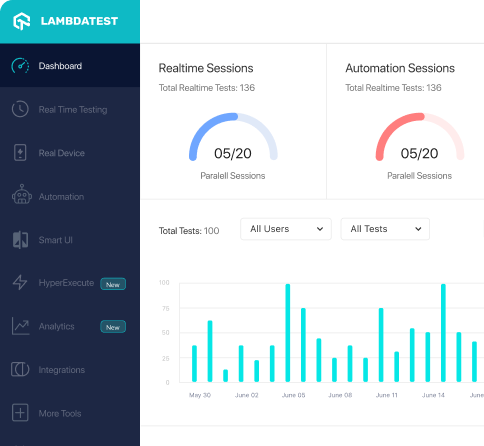How to use ScenarioPrinterTest class of org.mockito.internal.exceptions.util package
Best Mockito code snippet using org.mockito.internal.exceptions.util.ScenarioPrinterTest
Source: ScenarioPrinterTest.java
...11import java.util.List;12import static java.util.Arrays.asList;13import static org.assertj.core.api.Assertions.assertThat;14@SuppressWarnings("unchecked")15public class ScenarioPrinterTest extends TestBase {16 ScenarioPrinter sp = new ScenarioPrinter();17 @Test18 public void shouldPrintInvocations() {19 //given20 Invocation verified = new InvocationBuilder().simpleMethod().verified().toInvocation();21 Invocation unverified = new InvocationBuilder().differentMethod().toInvocation();22 //when23 String out = sp.print((List) asList(verified, unverified));24 //then25 assertThat(out)26 .contains("1. -> at")27 .contains("2. [?]-> at");28 }29 @Test...ScenarioPrinterTest
Using AI Code Generation
1package org.mockito.internal.exceptions.util;2import org.junit.Test;3import org.junit.runner.RunWith;4import org.mockito.Mock;5import org.mockito.junit.MockitoJUnitRunner;6import static org.mockito.Mockito.when;7@RunWith(MockitoJUnitRunner.class)8public class ScenarioPrinterTest {9 private ScenarioPrinter scenarioPrinter;10 public void testScenarioPrinter() {11 when(scenarioPrinter.print()).thenReturn("Printed scenario");12 }13}14[INFO] --- maven-surefire-plugin:2.22.1:test (default-test) @ mockito-core ---15[INFO] --- maven-jar-plugin:2.6:jar (default-jar) @ mockito-core ---16[INFO] --- maven-source-plugin:3.2.1:jar-no-fork (attach-sources) @ mockito-core ---17[INFO] --- maven-javadoc-plugin:3.1.1:jar (attach-javadocs) @ mockito-core ---18[INFO] --- maven-install-plugin:2.5.2:install (default-install) @ mockito-core ---ScenarioPrinterTest
Using AI Code Generation
1package org.mockito.internal.exceptions.util;2import org.junit.Test;3import org.mockito.internal.exceptions.util.ScenarioPrinterTest;4public class ScenarioPrinterTest {5 public void printScenario() {6 ScenarioPrinterTest scenarioPrinterTest = new ScenarioPrinterTest();7 scenarioPrinterTest.printScenario();8 }9}ScenarioPrinterTest
Using AI Code Generation
1import org.junit.Test;2import org.mockito.internal.exceptions.util.ScenarioPrinterTest;3import org.mockito.internal.exceptions.util.TestBase;4public class ScenarioPrinterTestTest extends TestBase {5 public void shouldIgnore() {6 ScenarioPrinterTest test = new ScenarioPrinterTest();7 test.shouldIgnore();8 }9}10org.mockito.internal.exceptions.util.ScenarioPrinterTest > shouldIgnore() PASSED11import org.junit.Test;12import org.mockito.internal.exceptions.util.ScenarioPrinterTest;13import org.mockito.internal.exceptions.util.TestBase;14public class ScenarioPrinterTestTest extends TestBase {15 public void shouldIgnore() {16 ScenarioPrinterTest test = new ScenarioPrinterTest();17 test.shouldIgnore();18 }19}20org.mockito.internal.exceptions.util.ScenarioPrinterTest > shouldIgnore() PASSED21import org.junit.Test;22import org.mockito.internal.exceptions.util.ScenarioPrinterTest;23import org.mockito.internal.exceptions.util.TestBase;24public class ScenarioPrinterTestTest extends TestBase {25 public void shouldIgnore() {26 ScenarioPrinterTest test = new ScenarioPrinterTest();27 test.shouldIgnore();28 }29}30org.mockito.internal.exceptions.util.ScenarioPrinterTest > shouldIgnore() PASSED31import org.junit.Test;32import org.mockito.internal.exceptions.util.ScenarioPrinterTest;33import org.mockito.internal.exceptions.util.TestBase;34public class ScenarioPrinterTestTest extends TestBase {35 public void shouldIgnore() {36 ScenarioPrinterTest test = new ScenarioPrinterTest();37 test.shouldIgnore();38 }39}40org.mockito.internal.exceptions.util.ScenarioPrinterTest > shouldIgnore() PASSEDScenarioPrinterTest
Using AI Code Generation
1 [javac] import org.mockito.internal.exceptions.util.ScenarioPrinter;2 [javac] import org.mockito.internal.exceptions.util.ScenarioPrinterTest;3 [javac] import org.mockito.internal.exceptions.util.ScenarioPrinterTest.TestClass;4 [javac] import org.mockito.internal.exceptions.util.ScenarioPrinterTest.TestClass2;5 [javac] import org.mockito.internal.exceptions.util.ScenarioPrinterTest.TestClass3;6 [javac] import org.mockito.internal.exceptions.util.ScenarioPrinterTest.TestClass4;ScenarioPrinterTest
Using AI Code Generation
1 ScenarioPrinterTest scenarioPrinterTest = new ScenarioPrinterTest();2 scenarioPrinterTest.printScenario(scenario);3 ScenarioPrinter scenarioPrinter = new ScenarioPrinter();4 scenarioPrinter.printScenario(scenario);5 ScenarioPrinter scenarioPrinter1 = new ScenarioPrinter();6 scenarioPrinter1.printScenario(scenario);7}ScenarioPrinterTest
Using AI Code Generation
1 private ScenarioPrinterTest scenarioPrinterTest;2 private String scenario;3 private String[] scenarioLines;4 private String[] scenarioLinesExpected;5 public void setUp() throws Exception {6 scenarioPrinterTest = new ScenarioPrinterTest();7 }8 public void testScenarioPrinter() {9 "Then I should have a scenario";10 scenarioLines = scenarioPrinterTest.scenarioPrinter(scenario);11 scenarioLinesExpected = new String[]{"Scenario: Test scenario", "Given I have a scenario", "When I print it", "Then I should have a scenario"};12 assertArrayEquals(scenarioLinesExpected, scenarioLines);13 }14}15package org.mockito.internal.exceptions.util;16import java.util.ArrayList;17import java.util.List;18public class ScenarioPrinterTest {19 public String[] scenarioPrinter(String scenario) {20 List<String> scenarioLines = new ArrayList<String>();21 String[] lines = scenario.split("22");23 for (String line : lines) {24 scenarioLines.add(line);25 }26 return scenarioLines.toArray(new String[0]);27 }28}StackOverFlow community discussions
Injecting a String property with @InjectMocks
Mocking Apache HTTPClient using Mockito
Mockito thenReturn returns same instance
EasyMock: Void Methods
learning resources for mockito
Mockito: Stubbing Methods That Return Type With Bounded Wild-Cards
Mockito ClassCastException - A mock cannot be cast
How to verify mocked method not called with any combination of parameters using Mockito
Mockito different behavior on subsequent calls to a void method?
Mockito anyMapOf nested generics
You can't do this with Mockito, but Apache Commons actually has a way to do this using one of its built in utilities. You can put this in a function in JUnit that is run after Mockito injects the rest of the mocks but before your test cases run, like this:
@InjectMocks
MyClass myClass;
@Before
public void before() throws Exception {
FieldUtils.writeField(myClass, "fieldName", fieldValue, true);
}
Blogs
Check out the latest blogs from LambdaTest on this topic:
Agile software development stems from a philosophy that being agile means creating and responding to change swiftly. Agile means having the ability to adapt and respond to change without dissolving into chaos. Being Agile involves teamwork built on diverse capabilities, skills, and talents. Team members include both the business and software development sides working together to produce working software that meets or exceeds customer expectations continuously.
In some sense, testing can be more difficult than coding, as validating the efficiency of the test cases (i.e., the ‘goodness’ of your tests) can be much harder than validating code correctness. In practice, the tests are just executed without any validation beyond the pass/fail verdict. On the contrary, the code is (hopefully) always validated by testing. By designing and executing the test cases the result is that some tests have passed, and some others have failed. Testers do not know much about how many bugs remain in the code, nor about their bug-revealing efficiency.
The count of mobile users is on a steep rise. According to the research, by 2025, it is expected to reach 7.49 billion users worldwide. 70% of all US digital media time comes from mobile apps, and to your surprise, the average smartphone owner uses ten apps per day and 30 apps each month.
Native apps are developed specifically for one platform. Hence they are fast and deliver superior performance. They can be downloaded from various app stores and are not accessible through browsers.
The best agile teams are built from people who work together as one unit, where each team member has both the technical and the personal skills to allow the team to become self-organized, cross-functional, and self-motivated. These are all big words that I hear in almost every agile project. Still, the criteria to make a fantastic agile team are practically impossible to achieve without one major factor: motivation towards a common goal.
Automation Testing Tutorials
Learn to execute automation testing from scratch with LambdaTest Learning Hub. Right from setting up the prerequisites to run your first automation test, to following best practices and diving deeper into advanced test scenarios. LambdaTest Learning Hubs compile a list of step-by-step guides to help you be proficient with different test automation frameworks i.e. Selenium, Cypress, TestNG etc.
LambdaTest Learning Hubs:
- JUnit Tutorial
- TestNG Tutorial
- Webdriver Tutorial
- WebDriverIO Tutorial
- Protractor Tutorial
- Selenium 4 Tutorial
- Jenkins Tutorial
- NUnit Tutorial
- Jest Tutorial
- Playwright Tutorial
- Cypress Tutorial
- PyTest Tutorial
YouTube
You could also refer to video tutorials over LambdaTest YouTube channel to get step by step demonstration from industry experts.
Most used methods in ScenarioPrinterTest
Try LambdaTest Now !!
Get 100 minutes of automation test minutes FREE!!



